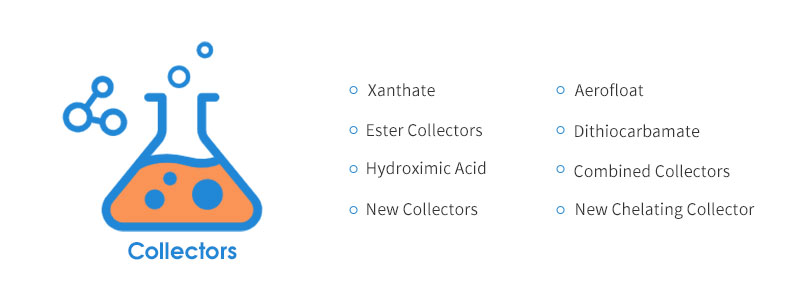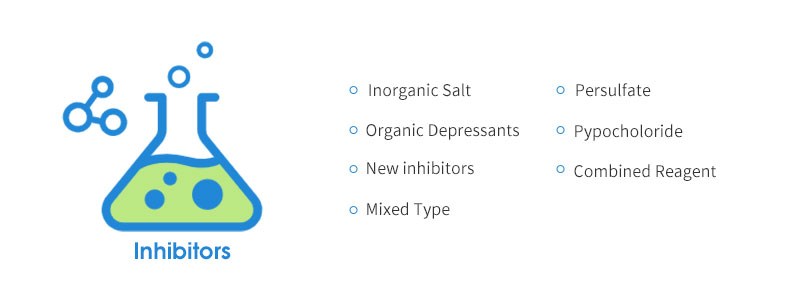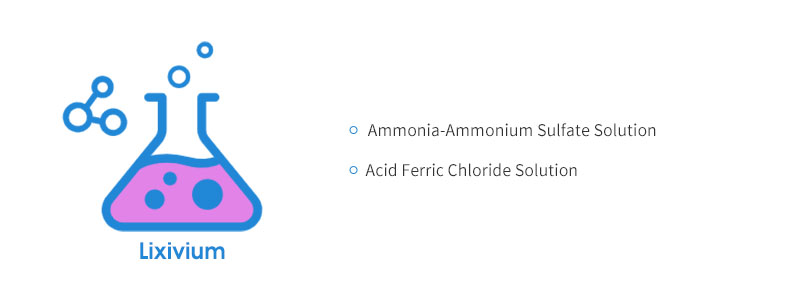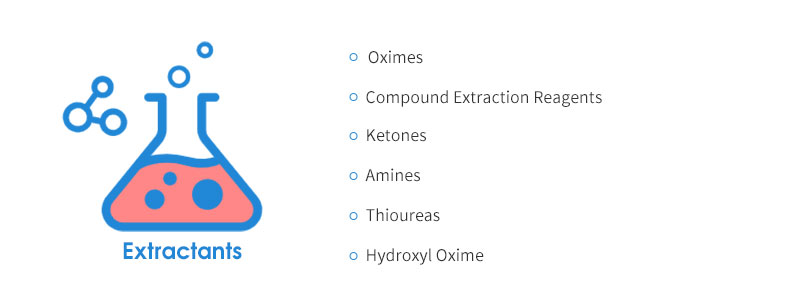In the flotation process of the copper mine, the use of flotation reagents to change the surface properties of the mineral is a flexible and effective way to control the flotation behavior. It is also an important reason why flotation can be widely used in mineral processing. This article mainly focuses on copper collectors, inhibitors, activators, foaming agents, ore-leaching bacteria, lixivium, extractants, etc.
Collectors
The collector can increase the hydrophobicity of the mineral surface, so that the ore particles can be firmly attached to the foam and float up.

Collectors of copper beneficiation
Xanthate
It is the collector of the sulphide ore with stronger collecting ability and weaker selectivity than the aerofloat.
SIPX (Sodium Isopropyl Xanthate)
Its collection ability is slightly stronger than that of sodium ethylxanthate as a precipitator in hydrometallurgy. It is also used as the accelerator of rubber vulcanization.
Y-89
Copper and sulfur in copper ore have strong collection properties, which is also conducive to improving the recovery of associated gold in copper sulphide ores. The flotation effect of refractory copper-sulfur ore containing secondary copper minerals is better than that with butyl xanthate, but its selectivity is worse.
Aerofloat
Aerofloat has a weak collection capacity and slow flotation speed for sulphide minerals, but its selectivity is better than that of xanthate collectors.
Ammonium Dibutyl Dithiophosphate
As the excellent collector and foaming agent for non-ferrous metal ores, it has a special separation effect on the copper, lead, silver and activated zinc sulfide ores and refractory polymetallic ores.
Dithiocarbamate
It has stronger collection capacity than xanthates, especially for chalcopyrite. It has weaker collection capacity for pyrite, but better selectivity and faster flotation speed. Better separation effect than xanthate can be obtained by using it in the separation of copper-lead sulfide ore.
Hydroximic Acid
It is mainly used for the flotation of copper oxide ore, which can be used for directly flotation or sulphidizing flotation. The flotation effect is better than that of xanthates alone.
Ester Collectors
Ester collectors have the strong collection capacity for chalcopyrite, but weaker collection capacity for sphalerite and pyrite.
Xanthate Ester
As the highly selective collector, it has very low solubility in water and high activity for flotation of copper, zinc, molybdenum and other sulfide ores, as well as precipitated copper, segregate copper, etc. It's often used in combination with water-soluble collectors to increase the efficacy, reduce dosage and improve selectivity.
BXEF (Butyl Xanthate Ethyl Formate): It has low solubility in water as a highly selective collector.
Dithiocarbamate Ester
It has good selectivity and foaming properties for chalcopyrite. Compared with xanthate and No. 2 oil, it can reduce the cost of chemicals and improve the mineral processing index.
YK1-11: Preferential copper selection collector.
Ester-105: It has selectivity and foaming property to reduce the cost of reagents and improve the mineral processing index.
DMDC: It has a strong collection capacity for copper and a weak collection capacity for pyrite and unactivated sphalerite. It can be used for copper and sulfur separation and its flotation index is higher than butyl xanthate.
Ammonium Sulphate
Z-200
It is a commonly used collector for sulfide ore flotation.
Thionocarbamates
Compared with the xanthate or aerofloat, it has higher selectivity and stability. It has a stronger collection effect on chalcopyrite and chalcocite, but a weaker collection ability on pyrite. The amount of pyrite inhibitor can be reduced during the flotation of copper sulfide.
Propionitrile Dimethyldithiocarbamate
It can be mixed with xanthate (amyl-xanthate, etc.) to improve the flotation index of the copper mine.
CSU-A
Novel thionocarbamate collector with three hydrocarbyls.
ECTC
It has strong collection capacity for copper, but weak for pyrite, with a low flotation PH. It is a good collector for the separation of copper and sulfur.
Combined Collectors
Combination of Isooctyl Thioglycolate and Butyl Xanthates
Its flotation effect is better than that of single reagent, which can improve the recovery of target minerals, reduce the dosage of reagents and the cost of mineral processing.
Combination of AT-680 and Ammonium Dibutyl Dithiophosphate
It can improve the grade and recovery rate of gold, silver and molybdenum associated with copper mines.
New Collectors
DEOECTU
It has excellent collection capacity for chalcopyrite, but weak collection capacity for pyrite, sphalerite and galena.
IOETCT
It can effectively float copper in low alkaline medium and improve the recovery rate of gold and silver.
BK901
It can selectively collect copper minerals with low toxicity and high efficiency.
BK905
Excellent for flotation of copper minerals.
BK204
Excellent for flotation of copper minerals.
CSU-21
Under the condition of alkalescence, it has good collecting ability and selectivity for chalcopyrite and other copper-bearing minerals, as well as strong collecting ability for associated precious metals such as gold and silver.
CSU-31
The selective flotation separation of chalcopyrite and pyrite can be achieved in neutral or alkaline media with a low concentration of it.
A2
As the high-efficiency collecting and foaming agent for copper and gold, A2 has a high selection rate and good separation effect of copper-gold and sulfur.
J622
The collector of Cu-Ni ores.
BJ-306
The collector of copper, gold and silver.
QF
QF collector, containing thiocarbonyl functional groups, has strong collection capacity for natural gold, chalcopyrite and other minerals. Its ability to collect gold and copper is higher than that of low-grade xanthate and dithiocarbamate collectors.
T-2K
T-2K has the advantages of strong collection ability, high selectivity and partial foaming ability when processing copper sulfide ore or gold and silver-bearing copper sulfide ore.
PN405
PN405 has a strong selective collecting and foaming capacity for copper ore. By using this agent alone or with a small number of xanthate collectors, a better selection index can be obtained when floating the copper. It is also a high-efficiency collecting and foaming agent for copper-nickel sulfide ore to be used in conjunction with Y89 xanthate.
MOS-2
MOS-2 has strong new selective collecting ability for copper ore and weak collecting ability for pyrite. The separation of copper and sulfur can be realized and the dosages of collectors, lime and no. 2 oil can be reduced in lower alkaline medium by using it. Mos-2 collector also has a good foaming performance, so when using it as a collector, less or no foaming agent can be used.
ML
High flotation indexes can be obtained for copper sulfide associated with hydrothermal alteration.
Mac-2
It is a collector for copper sulfide and surface oxidized copper sulfide, especially for associated gold.
PLQ1
It is a new class of ester collector for copper sulfide, which can preferentially collect copper in the rough selection stage with strong chemical adsorption on the surface of copper, and it is not easy to fall off.
EP
It has good collecting performance and selectivity for copper sulfide, good selectivity for skarn copper ore with high secondary copper content, and can separate copper and sulfur in low alkaline medium.
LW61
The collector of copper and silver.
BP
It is a high-efficiency copper collector with the foaming effect, which can significantly improve the copper grade and recovery rate.
New Chelating Collector
KM109
It is a collector of copper sulfide ore, which has both foaming properties with rich and non-sticky foam, good selectivity, strong collecting property and fast flotation speed to improve concentrate grade. It has a wide PH range and can be added in stock solution.
B130
It is a modified chalcophile chelating agent, which has no other hydration group except the groups that can form chelating compounds with copper, and can form stable hydrophobic polymers insoluble in water (or with very low solubility) with the surface of copper oxide.
Inhibitors
By selectively inhibiting the interaction of a mineral with a collector, inhibitors are often used to increase the efficiency of the flotation process.

Inhibitors of copper beneficiation
Inorganic Salt
Sodium Silicate
Sodium silicate is an inhibitor of quartz, silicate and aluminosilicate minerals, and a dispersant of sludge.
Organic Depressants
Lactic Acid
The depressant of pyrite.
Tannic Acid
The depressant of pyrite.
Salicylic Acid
The depressant of pyrite.
Pyrogallic Acid
The depressant of pyrite.
Starch
The depressant of pyrite.
New inhibitors
LD
It has a strong inhibitory effect on sulphide ores other than chalcopyrite. It can avoid the inhibitory effect on chalcopyrite when using too much sodium sulfide. It can be used in combination with sodium sulfite and zinc sulfate.
YF851
Copper inhibition and molybdenum floatation.
YF212
Copper inhibition and molybdenum floatation.
PGA (Pseudo Glycolylthiourea Acid)
PGA is an inhibitor of copper inhibition and molybdenum floatation. Its adsorption strength in chalcopyrite is greater than that of molybdenite.
EM-421
As a highly effective inhibitor of arsenopyrite and pyrite, it can effectively separate copper and arsenic (sulphur) without increasing PH value.
Mixed Type
DP-1
It belongs to organic quinone and peracetic acid, as an effective Cu-S inhibitor of sulphide minerals.
Persulfate
DP-2
Effective Cu-S separation inhibitors of sulfide minerals.
Pypocholoride
DP-3
Effective Cu-S separation inhibitors of sulfide minerals
Combined Reagent
T-16 + Zinc Sulfate
The combination of T-16 + zinc sulfate inhibitor can inhibit zinc, activate copper and lead, and eliminate the effect of slurry foam viscosity, which can effectively realize the flotation separation of copper-lead and zinc.
Activators
It can enhance the action of minerals and collectors, so that the refractory minerals are activated and floated.

Activators of copper beneficiation
Vulcanizer
Sodium Hydrosulfide
The activator of oxidized ore.
Sodium Sulfide
The activator of oxidized ore.
New Reagent
YC
It can improve the surface activity of copper minerals. When copper and lead are separated, it can improve the copper grade and recovery rate and reduce the lead content in copper concentrates.
Foaming Agents
In order to produce the large and stable foams necessary for flotation, foaming agents must be added to the pulp.

Foaming agents of copper beneficiation
Synthetic Alcohols
Synthetic Alcohol
It has wide application prospects and can replace natural foaming agents.
Ether Alcohol
It has wide application prospects and can replace natural foaming agents.
MIBC (Methyl Isobutylcarbinol)
It has wide application prospects.
Butyl Ether Alcohol
It tends to replace natural foaming agents.
Organic Reagents
Fusel oil
As a by-product of the brewing industry, it contains isoamyl alcohol, ethanol, propanol, isobutanol and n-butanol.
JM-208
It is a yellow to brown oily liquid with a slight alcohol odour. When its recovery rate is close to other foaming agents, it can improve the concentrate grade.
Diethylene Glycol Monobutyl Ether
It can effectively improve the flotation recovery rate with better foam recovery rate than MIBC and terpenic oil.
Terpenic Oil
As an excellent foaming reagent with low cost, it is the most widely used in production.
TEB (1,1,3-Triethyl Orthobutyrate)
It has good foaming properties and is used in non-ferrous metal processing plants in the United States, South Africa, Canada and Russia.
Leaching Bacteria
One of the development trends of mining is the application of bioleaching technology to recover important metals from various low-grade ores. Compared with traditional mineral processing technology, biological leaching technology has the characteristics of low cost, easy operation and low pollution.

Leaching bacteria of copper beneficiation
Mesophilic Bacteria
It can effectively leach chalcocite, covellite and other secondary sulfide ores with optimal growth temperature of 20 ~ 35 ℃. It's the main bacterial species for biological copper leaching.
Moderate Thermophilic Bacteria
Its optimal growth temperature is 40 ~ 50 ℃.
Hyperthermophiles
Its optimal growth temperature is 60 ~ 85 ℃.
Acidithiobacillus ferrooxidans
It can oxidize ferrous ions and reducible sulfur to realize the leaching of metal ions.
YN12 (Moderate Thermophilic Sulphur-oxidizing Bacteria)
It belongs to acidithiobacillus caldus.
No.26 Strain (Thiobacillus Ferrosulphide Acidophilus)
Methods of Cu2+ concentration gradient culture and ultraviolet mutation can be used to keep its growth performance stable and improve the oxidation activity.
Lixivium
Useful elements enter the lixivium as ions in preparation for solid-liquid separation.

Lixivium of copper beneficiation
Ammonia-Ammonium Sulfate Solution
It is selective and can reduce the entry of Ca, Mg, and Fe ions.
Acid Ferric Chloride Solution
It can effectively separate copper, lead, zinc, gold, silver, etc.
Extractants
The extractant can chemically react with the extract to form an extractable compound that can be dissolved in the organic phase, which is the most critical factor affecting the success of the extraction process.

Extractants of copper beneficiation
Oximes
Oxime Copper Extractant
It has good effect under the acid condition with good physical properties, good phase separation, low entrainment loss and easy back extraction.
LIX64
The representative product of oxime structure copper extractants.
LIX65N
The representative product of oxime structure copper extractants.
LIX622
The representative product of oxime structure copper extractants.
LIX70
The representative product of oxime structure copper extractants.
LIX84
The representative product of oxime structure copper extractants.
LIX860
The representative product of oxime structure copper extractants.
LIX86-1
The representative product of oxime structure copper extractants.
SME529
The representative product of oxime structure copper extractants.
CA-12
It has the advantages of non-toxic and large extraction capacity.
Compound Extraction Reagents
Ketoxime Compound Extraction Agent
It is mainly composed of ketoxime and aldoxime, oxime and B -diketone, ketoxime and other compounds.
LIX984N (LIX984+ Nonyl Phenol)
It's currently the most typical and most widely used one.
M5640
It's currently the most typical and most widely used one.
Ketones
β- Diketone Extraction Agent
It is used for liquid-liquid ion exchange in aqueous solution and ammonia spirit.
Amines
Triamines Extraction Agent
It is suitable for extracting copper in acidic high-chlorine solution and can be back-extracted with water.
TBDGA
Copper ions can be extracted with toluene as the diluent and the extraction can reach about 90% after level-3 extraction.
Thioureas
Mac-10
Modified thiourea extractant.
Mac-12
Modified thiourea extractant.
Hydroxyl Oxime
HNAO
It is a high-efficiency copper extractant and is widely used in the field of wet smelting copper.
LIX84-I
The copper extraction and back-extraction can be completed in the ammonia solution.
N902
It has the advantages of high extraction saturation capacity, good phase separation effect and high acid resistance.
In the flotation process of copper ore, the beneficiation reagent is an important factor that determines the flotation effect. It is one of the main research directions of mineral processing workers to explore a new copper flotation process and develop new cost-effective and environmentally friendly reagents to improve the utilization rate of copper resources.



